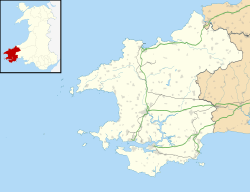History
The earliest-known record of Scoveston is from the 15th century, with some other settlements in the immediate area dating from the 16th to 18th centuries. [2] In 1644–45, Thomas Butler of Scoveston was High Sheriff of Pembrokeshire. [3] By 1863, the house had been rebuilt and was occupied by William Rees, another High Sheriff. [4] Scoveston and Upper Scoveston appear on a pre-1850 parish map of Llanstadwell, [5] but were not mentioned in 19th century gazetteers. [6]
Richard Fenton, in his 1811 Pembrokeshire tour, noted the mansion at Scoveston as being a venerable building transmuted into a farm-house, and having been owned by the Mordaunt family, one which was poorly documented. [7]
Upper Scoveston (also referred to as Scoveston Park or Scoveston Manor) was noted by the 1911 Royal Commission as including a boathouse, possible isolated geometric copses, sundial, well, walled garden and lake. [8]
On modern maps, the name is applied to the road passing through the settlement, as well as Upper Scoveston, Lower Scoveston, Middle Scoveston and Scoveston Grove. [1]
In 1985, Scoveston Manor was the scene of a double murder and extensive fire. John Cooper was later convicted of this and other crimes. [9] [10] The following year, the house was sold and repurposed. [4]
This page is based on this
Wikipedia article Text is available under the
CC BY-SA 4.0 license; additional terms may apply.
Images, videos and audio are available under their respective licenses.
